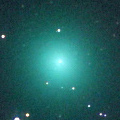
|
It brightened rapidly. Now it is very bright as 8.1 mag (Dec. 30, Uwe Pilz). It will approach to the sun down to 0.3 a.u. on Jan. 14. It is not observable at all in the Southern Hemisphere. It will be unobservable soon also in the Northern Hemisphere.
Date(TT) R.A. (2000) Decl. Delta r Elong. m1 Best Time(A, h)
Dec. 31 17 24.43 2 18.5 0.868 0.516 31 7.8 5:37 (275, 12)
Jan. 7 17 58.82 -8 53.5 1.001 0.382 22 6.8 5:38 (284, 4)
|
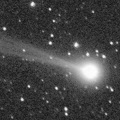
|
It brightened very rapidly as predicted. Now it is very bright as 7.2 mag (Dec. 29, Marco Goiato). It will approach to the earth down to 0.08 a.u. to the earth in mid February, and it is expected to be observable at 6 mag in good condition. It will be unobservable temporarily in January. Then it keeps observable in good condition after mid February.
Date(TT) R.A. (2000) Decl. Delta r Elong. m1 Best Time(A, h)
Dec. 31 20 56.91 -19 7.1 0.712 0.533 31 7.2 18:28 ( 59, 10)
Jan. 7 21 8.86 -17 13.6 0.564 0.552 27 6.9 18:33 ( 63, 7)
|
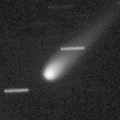
|
Now it is 11.5 mag (Dec. 30, Uwe Pilz). It is expected to brighten up to 7 mag in 2017 summer. In the Northern Hemisphere, it keeps observable in good condition until the highlight while the comet will be brightening. In the Southern Hemisphere, it is not observable until early 2017.
Date(TT) R.A. (2000) Decl. Delta r Elong. m1 Best Time(A, h)
Dec. 31 14 30.97 44 2.0 2.493 2.651 88 10.9 5:37 (241, 63)
Jan. 7 14 45.76 44 2.6 2.391 2.587 90 10.7 5:38 (240, 65)
|
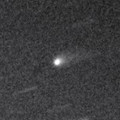
|
Now it is 13.0 mag (Dec. 29, Chris Wyatt). It is expected to brighten up to 7 mag in 2017 spring. But it locates somewhat low at the high light.
Date(TT) R.A. (2000) Decl. Delta r Elong. m1 Best Time(A, h)
Dec. 31 15 4.67 -19 45.0 2.736 2.239 50 12.2 5:37 (317, 22)
Jan. 7 15 20.60 -20 38.6 2.590 2.156 53 11.9 5:38 (320, 23)
|

|
Now it is 15.5 mag (Dec. 6, Kunihiro Shima). It will brighten up to 12 mag from winter to spring. In the Northern Hemisphere, it keeps observable while the comet is brightening gradually. But it will be unobservable in late February. In the Southern Hemisphere, it keeps observable for a long time after this.
Date(TT) R.A. (2000) Decl. Delta r Elong. m1 Best Time(A, h)
Dec. 31 15 5.68 -9 33.5 1.769 1.418 53 13.4 5:37 (310, 30)
Jan. 7 15 31.12 -11 38.1 1.684 1.356 53 13.2 5:38 (312, 29)
|

|
Already bright as 12.0 mag (Dec. 21, Thomas Lehmann). It will pass the perihelion on Mar. 10, 2017. In the Northern Hemisphere, it keeps observable in the evening sky until late February while the comet will be brightening up to 8.5 mag. In the Southern Hemisphere, it will appear in the morning sky in late March at 8 mag, then it keeps observable while the comet will be fading.
Date(TT) R.A. (2000) Decl. Delta r Elong. m1 Best Time(A, h)
Dec. 31 23 1.17 4 5.7 1.422 1.407 68 14.3 18:28 ( 51, 47)
Jan. 7 23 6.93 4 22.2 1.412 1.308 63 13.5 18:33 ( 58, 43)
|

|
It was observed as bright as 12-13 mag from late October to early November. Now it is not observable. It will appear in the morning sky in March.
Date(TT) R.A. (2000) Decl. Delta r Elong. m1 Best Time(A, h)
Dec. 31 20 9.16 -21 28.6 6.788 5.876 20 13.9 18:28 ( 64, -1)
Jan. 7 20 14.95 -21 6.0 6.821 5.875 14 13.9 18:33 ( 68, -5)
|
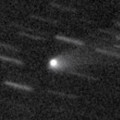
|
Now it is 15.2 mag (Nov. 17, Ken-ichi Kadota). It will brighten up to 14 mag from winter to spring, and it will be observable in excellent condition in the Northern Hemisphere. It keeps low in the Southern Hemisphere.
Date(TT) R.A. (2000) Decl. Delta r Elong. m1 Best Time(A, h)
Dec. 31 11 49.28 25 38.6 1.897 2.428 110 14.2 5:11 ( 0, 81)
Jan. 7 11 55.51 26 11.5 1.834 2.433 116 14.2 4:49 ( 0, 81)
|
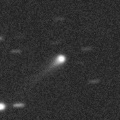
|
It brightened very rapidly up to 12 mag in autumn, brighter than originally expected. It will not be observable after this.
Date(TT) R.A. (2000) Decl. Delta r Elong. m1 Best Time(A, h)
Dec. 31 19 41.94 -13 3.5 3.002 2.085 17 14.3 18:28 ( 75, -1)
Jan. 7 19 58.30 -12 5.7 3.037 2.103 15 14.6 18:33 ( 78, -3)
|

|
Now it is 14.2 mag (Nov. 22, Chris Wyatt). Distant object, but it keeps observable at 13-14 mag for a long time from 2015 to 2016.
Date(TT) R.A. (2000) Decl. Delta r Elong. m1 Best Time(A, h)
Dec. 31 0 42.66 -4 45.5 5.064 5.132 88 14.6 18:28 ( 10, 50)
Jan. 7 0 45.99 -4 27.3 5.187 5.148 82 14.7 18:33 ( 21, 49)
|
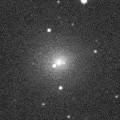
|
It brightened up to 11-12 mag in autumn. Now it is fading. But it is bright as 13.3 mag still now (Dec. 2, Seiichi Yoshida). It is getting higher gradually after this also in the Southern Hemisphere.
Date(TT) R.A. (2000) Decl. Delta r Elong. m1 Best Time(A, h)
Dec. 31 13 18.79 -12 35.2 1.924 1.948 76 14.7 5:37 (340, 40)
Jan. 7 13 27.96 -13 35.5 1.892 1.995 81 14.9 5:38 (346, 40)
|
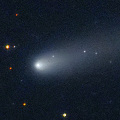
|
It brightened up to 11-12 mag from summer to autumn. Now it is fading. But it is bright as 12.4 mag still now (Dec. 29, Jakub Cerny).
Date(TT) R.A. (2000) Decl. Delta r Elong. m1 Best Time(A, h)
Dec. 31 12 17.77 -21 29.9 1.755 1.963 86 14.8 5:37 (359, 33)
Jan. 7 12 23.41 -22 55.4 1.724 2.011 91 14.9 5:17 ( 0, 32)
|

|
Now it is bright as 15.3 mag (Nov. 22, Thomas Lehmann). It will be observable at 11 mag for a long time from 2017 to 2018. Now it is observable in excellent condition in the Southern Hemisphere. But it keeps low for a while in the Northern Hemisphere.
Date(TT) R.A. (2000) Decl. Delta r Elong. m1 Best Time(A, h)
Dec. 31 2 51.10 -36 54.8 5.213 5.456 99 15.0 20:10 ( 0, 18)
Jan. 7 2 48.86 -35 44.6 5.231 5.404 94 14.9 19:40 ( 0, 19)
|

|
It brightened up to 11 mag from spring to summer. Now it is not observable. It will be observable at 16 mag again in 2017 spring.
Date(TT) R.A. (2000) Decl. Delta r Elong. m1 Best Time(A, h)
Dec. 31 17 31.64 -21 18.2 3.138 2.211 16 15.0 5:37 (294, -4)
Jan. 7 17 46.85 -21 26.9 3.152 2.251 19 15.1 5:38 (296, -1)
|

|
Now it is 15.4 mag (Dec. 2, Kunihiro Shima). It keeps 15 mag until spring. But it will be getting lower gradually after this.
Date(TT) R.A. (2000) Decl. Delta r Elong. m1 Best Time(A, h)
Dec. 31 23 10.86 3 15.8 1.879 1.809 70 15.3 18:28 ( 47, 48)
Jan. 7 23 24.40 4 59.3 1.916 1.786 67 15.2 18:33 ( 54, 47)
|

|
Now it is 15.0 mag (Dec. 6, Kunihiro Shima). It will brighten up to 12-13 mag and will be observable in good condition in 2017 summer. In this winter, it is observable until mid January in the Southern Hemisphere, or until the end of February in the Northern Hemisphere.
Date(TT) R.A. (2000) Decl. Delta r Elong. m1 Best Time(A, h)
Dec. 31 0 19.64 17 20.1 3.486 3.654 91 15.5 18:28 ( 35, 69)
Jan. 7 0 15.33 16 23.8 3.583 3.609 83 15.5 18:33 ( 52, 63)
|

|
It brightened up to 6 mag from last autumn to last winter. Now it is fading. It has already faded down to 15.2 mag (Nov. 2, Yuji Ohshima). It is observable in good condition in the Northern Hemisphere. It is not observable after this in the Southern Hemisphere.
Date(TT) R.A. (2000) Decl. Delta r Elong. m1 Best Time(A, h)
Dec. 31 3 13.19 52 4.3 4.686 5.383 131 15.7 20:32 (180, 73)
Jan. 7 3 6.69 50 59.4 4.826 5.451 125 15.8 19:58 (180, 74)
|

|
It will brighten up to 14 mag from spring to summer in 2017. It locates somewhat low in the Northern Hemisphere. The perihelion distance increased from 2.4 a.u. to 2.9 a.u. in this apparition. So it will not be bright as before.
Date(TT) R.A. (2000) Decl. Delta r Elong. m1 Best Time(A, h)
Dec. 31 15 12.28 -14 16.6 3.774 3.231 50 15.8 5:37 (312, 25)
Jan. 7 15 21.16 -14 56.8 3.681 3.218 54 15.7 5:38 (316, 28)
|

|
Now it is 15.8 mag (Dec. 3, Kunihiro Shima). It will brighten up to 14 mag from summer to winter in 2017. Then it will be observable in excellent condition in the Northern Hemisphere. In the Southern Hemisphere, it is hardly observable around the highlight.
Date(TT) R.A. (2000) Decl. Delta r Elong. m1 Best Time(A, h)
Dec. 31 22 51.25 -5 19.6 4.381 4.025 62 15.8 18:28 ( 46, 38)
Jan. 7 22 53.54 -4 7.9 4.444 3.987 56 15.7 18:33 ( 54, 35)
|

|
Now it is 16.8 mag (Dec. 1, Kunihiro Shima). It will be observable at 16-17 mag in good condition from autumn to winter. It locates low in the Southern Hemisphere.
Date(TT) R.A. (2000) Decl. Delta r Elong. m1 Best Time(A, h)
Dec. 31 7 13.25 26 34.1 2.801 3.777 171 15.8 0:36 ( 0, 82)
Jan. 7 7 8.03 26 51.4 2.789 3.770 175 15.8 0:03 ( 0, 82)
|

|
Appearing in the morning sky in the Northern Hemisphere. Now it is fading. But it must be bright as 15 mag still now.
Date(TT) R.A. (2000) Decl. Delta r Elong. m1 Best Time(A, h)
Dec. 31 15 39.95 -20 10.3 2.861 2.231 42 15.8 5:37 (310, 17)
Jan. 7 15 52.78 -20 29.8 2.868 2.300 46 15.9 5:38 (314, 19)
|

|
It kept bright 12 mag for a long time from autum in 2015 to summer in 2016. Now it is fading. It is appearing in the morning sky in the Northern Hemispehre. It will be observable in late January also in the Southern Hemisphere.
Date(TT) R.A. (2000) Decl. Delta r Elong. m1 Best Time(A, h)
Dec. 31 16 56.91 -2 27.5 4.793 4.000 32 15.8 5:37 (284, 14)
Jan. 7 17 1.80 -3 8.0 4.791 4.049 37 15.9 5:38 (288, 19)
|
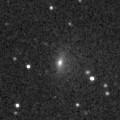
|
Now it is 15.7 mag (Dec. 15, Kunihiro Shima). It keeps 16-17 mag for a long time from 2016 to 2019. It keeps locating near by the equator.
Date(TT) R.A. (2000) Decl. Delta r Elong. m1 Best Time(A, h)
Dec. 31 9 21.35 1 45.2 8.931 9.660 135 16.0 2:43 ( 0, 57)
Jan. 7 9 20.27 1 53.4 8.854 9.655 142 15.9 2:15 ( 0, 57)
|
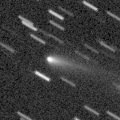
|
Now it is 15.8 mag (Nov. 23, Katsumi Yoshimoto). It will be observable at 15-16 mag in good condition from autumn to winter. It locates somewhat low in the Southern Hemisphere.
Date(TT) R.A. (2000) Decl. Delta r Elong. m1 Best Time(A, h)
Dec. 31 4 4.33 32 47.2 1.948 2.805 144 16.2 21:23 ( 0, 88)
Jan. 7 4 3.26 32 21.3 2.026 2.828 137 16.4 20:55 ( 0, 87)
|

|
Now it is 18.8 mag (Dec. 8, Mt. Lemmon Survey). It will approach to the earth down to 0.14 a.u. from March to April. It is expected to brighten up to 5-6 mag. It may brighten furthermore in outburst. In the Northern Hemisphere, it keeps observable in excellent condition. In the Southern Hemisphere, it will not be observable for about one month around the highlight. But it keeps observable in good condition except for that period.
Date(TT) R.A. (2000) Decl. Delta r Elong. m1 Best Time(A, h)
Dec. 31 9 18.00 7 23.9 0.791 1.665 139 17.0 2:40 ( 0, 62)
Jan. 7 9 22.39 7 28.2 0.696 1.605 145 16.4 2:17 ( 0, 62)
|

|
Now it is 16.6 mag (Dec. 1, Kunihiro Shima). It will brighten up to 15 mag and will be observable in good condition from autum to winter in 2017. In the Northern Hemisphere, it keeps observable in good condition for a long time while the comet will be brightening. It is not observable until 2017 summer in the Southern Hemisphere.
Date(TT) R.A. (2000) Decl. Delta r Elong. m1 Best Time(A, h)
Dec. 31 2 10.21 49 26.0 4.564 5.148 121 16.4 19:29 (180, 76)
Jan. 7 2 4.09 47 43.0 4.624 5.117 114 16.4 18:56 (180, 77)
|

|
It will brighten up to 10 mag in summer, and it will be observable in excellent condition in the Southern Hemisphere. It locates low in the Northern Hemisphere.
Date(TT) R.A. (2000) Decl. Delta r Elong. m1 Best Time(A, h)
Dec. 31 13 58.32 -4 15.1 2.383 2.257 70 16.8 5:37 (323, 44)
Jan. 7 14 10.20 -5 17.1 2.267 2.219 74 16.5 5:38 (329, 45)
|

|
Now it is 15.8 mag (Sept. 9, Alexander Baransky). It keeps 16.5 mag from 2016 to 2017. In the Northern Hemisphere, it keeps observable in good condition for a long time, although it becomes low temporarily in December. In the Southern Hemisphere, it will never be observable again.
Date(TT) R.A. (2000) Decl. Delta r Elong. m1 Best Time(A, h)
Dec. 31 17 49.05 35 12.5 6.686 6.246 59 16.6 5:37 (243, 24)
Jan. 7 17 55.44 35 56.5 6.663 6.247 61 16.6 5:38 (244, 29)
|
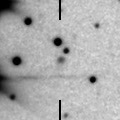
|
Now it is 16.7 mag (Nov. 3, iTelescope Observatory, Siding Spring). It keeps 16 mag for a long time from 2017 to 2018.
Date(TT) R.A. (2000) Decl. Delta r Elong. m1 Best Time(A, h)
Dec. 31 9 33.36 -10 19.9 5.217 5.852 126 16.8 2:55 ( 0, 45)
Jan. 7 9 28.45 -9 40.2 5.109 5.832 133 16.7 2:23 ( 0, 45)
|

|
It brightened up to 15 mag in early 2016. Now it is fading. It has already faded down to 16.3 mag (Dec. 6, Kunihiro Shima). In the Northern Hemisphere, it keeps observable in good condition for a long time until 2017 autumn when the comet will be fainter than 18 mag. It will never be observable after this in the Southern Hemisphere.
Date(TT) R.A. (2000) Decl. Delta r Elong. m1 Best Time(A, h)
Dec. 31 15 10.33 66 23.4 5.963 6.174 97 16.8 5:37 (205, 50)
Jan. 7 15 17.45 66 43.6 5.968 6.202 99 16.8 5:38 (203, 51)
|

|
It has been lost since its discovery in 1978. In 2016, it is expected to return in excellent condition from autumn to winter.
Date(TT) R.A. (2000) Decl. Delta r Elong. m1 Best Time(A, h)
Dec. 31 0 39.05 2 34.0 1.011 1.416 90 16.8 18:28 ( 13, 57)
Jan. 7 1 0.95 5 31.9 1.076 1.452 89 17.2 18:33 ( 20, 59)
|
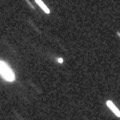
|
Now it is 16.9 mag (Nov. 25, Ken-ichi Kadota). It brightened rapidly, and became brighter than originally expected. It keeps 17 mag until 2017. In the Northern Hemisphere, it keeps observable in excellent condition for a long time. It is not observable in the Southern Hemisphere.
Date(TT) R.A. (2000) Decl. Delta r Elong. m1 Best Time(A, h)
Dec. 31 13 46.13 56 9.5 7.090 7.334 100 16.9 5:37 (209, 64)
Jan. 7 13 44.80 56 43.8 7.035 7.340 104 16.9 5:38 (201, 66)
|
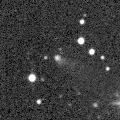
|
It brightened rapidly up to 16.3 mag in autumn (Sept. 7, Alexander Baransky). Now it is 17.2 mag (Dec. 8, Kunihiro Shima). It is observable until mid January in the Southern Hemisphere, or until March in the Northern Hemisphere.
Date(TT) R.A. (2000) Decl. Delta r Elong. m1 Best Time(A, h)
Dec. 31 23 22.55 -1 35.2 2.728 2.586 71 16.9 18:28 ( 40, 46)
Jan. 7 23 31.54 -0 20.8 2.806 2.581 66 17.0 18:33 ( 48, 44)
|

|
It brightened up to 8-9 mag from last winter to spring. Now it is fading. It has already faded down to 16.4 mag (Dec. 2, Ken-ichi Kadota).
Date(TT) R.A. (2000) Decl. Delta r Elong. m1 Best Time(A, h)
Dec. 31 13 15.26 -11 15.1 4.730 4.625 77 17.0 5:37 (340, 42)
Jan. 7 13 15.58 -12 0.2 4.670 4.683 84 17.1 5:38 (350, 42)
|

|
Now it is 17.3 mag (Nov. 7, Mt. Lemmon Survey). It is observable at 17 mag in good condition in winter.
Date(TT) R.A. (2000) Decl. Delta r Elong. m1 Best Time(A, h)
Dec. 31 12 33.50 -1 17.1 2.255 2.480 91 17.1 5:37 (352, 53)
Jan. 7 12 39.20 -1 27.9 2.191 2.510 97 17.1 5:33 ( 0, 53)
|
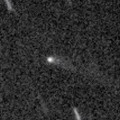
|
Now it is 17.8 mag (Dec. 3, Kunihiro Shima). It was observed at 17 mag last winter. It will be observable at 17 mag again next winter. It is observable in good condition in the Northern Hemisphere. But it locates low in the Southern Hemisphere.
Date(TT) R.A. (2000) Decl. Delta r Elong. m1 Best Time(A, h)
Dec. 31 11 24.58 22 23.4 3.408 3.931 115 17.1 4:46 ( 0, 77)
Jan. 7 11 26.35 24 1.0 3.342 3.953 122 17.1 4:20 ( 0, 79)
|

|
Now it is 17.4 mag (Nov. 25, Ken-ichi Kadota). In the Northern Hemisphere, it will be observable at 17 mag in excellent condition in winter. It locates low in the Southern Hemisphere.
Date(TT) R.A. (2000) Decl. Delta r Elong. m1 Best Time(A, h)
Dec. 31 7 3.79 34 56.1 2.447 3.413 167 17.1 0:27 ( 0, 90)
Jan. 7 6 59.00 34 60.0 2.454 3.420 167 17.1 23:50 ( 0, 90)
|

|
It brightened up to 6.2 mag in June (June 24, Marco Goiato). Now it is fading. It has already faded down to 13.3 mag in September (Sept. 28, Chris Wyatt). Now it is appearing in the morning sky. In the Southern Hemisphee, it keeps observable in excellent condition after this. It keeps low in the Northern Hemisphere.
Date(TT) R.A. (2000) Decl. Delta r Elong. m1 Best Time(A, h)
Dec. 31 15 6.96 -32 27.0 4.147 3.563 47 17.1 5:37 (324, 11)
Jan. 7 15 7.13 -32 53.2 4.116 3.634 54 17.3 5:38 (330, 14)
|

|
It will pass the perihelion in 2019. However, it has not been brightening since the discovery in 2010. Now it is 17.3 mag (Nov. 4, D. Buczynski). It keeps observable in excellent condition in the Northern Hemisphere. It is not observable in the Southern Hemisphere.
Date(TT) R.A. (2000) Decl. Delta r Elong. m1 Best Time(A, h)
Dec. 31 3 52.93 61 57.1 8.937 9.621 131 17.2 21:12 (180, 63)
Jan. 7 3 49.38 61 48.2 8.968 9.602 127 17.2 20:41 (180, 63)
|
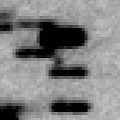
|
It will be observable at 17.5 mag in good condition from winter to spring.
Date(TT) R.A. (2000) Decl. Delta r Elong. m1 Best Time(A, h)
Dec. 31 13 58.30 -6 26.8 2.418 2.274 69 17.4 5:37 (325, 42)
Jan. 7 14 9.12 -7 20.9 2.349 2.284 74 17.4 5:38 (331, 43)
|

|
Now it is 17.3 mag (Nov. 9, L. Elenin). It keeps 17 mag for a long time from 2016 autumn to 2017 summer, and it keeps observable good condition all through that period in the Southern Hemisphere. In the Northern Hemisphere, it will never be observable again after this.
Date(TT) R.A. (2000) Decl. Delta r Elong. m1 Best Time(A, h)
Dec. 31 2 1.74 -64 48.0 2.539 2.512 77 17.5 19:20 ( 0,-10)
Jan. 7 1 49.97 -64 30.2 2.584 2.495 73 17.5 18:41 ( 0, -9)
|
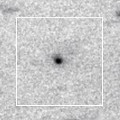
|
Now it is 17.5 mag (Oct. 24, D. Buczynski). It will brighten up to 16 mag in 2017 summer, but it is not observable around the high light. It is observable at 17-18 mag until March in the Southern Hemisphere, or until April in the Northern Hemisphere.
Date(TT) R.A. (2000) Decl. Delta r Elong. m1 Best Time(A, h)
Dec. 31 2 0.92 2 18.7 2.183 2.672 109 17.7 19:20 ( 0, 57)
Jan. 7 2 2.66 2 57.4 2.238 2.637 102 17.7 18:55 ( 0, 58)
|

|
Now it is 17.0 mag (Nov. 10, Purple Mountain Observatory, XuYi Station). It keeps observable at 17.5 mag in good condition from autumn to winter.
Date(TT) R.A. (2000) Decl. Delta r Elong. m1 Best Time(A, h)
Dec. 31 3 4.85 14 34.8 2.347 3.056 128 17.8 20:24 ( 0, 70)
Jan. 7 3 5.47 14 35.1 2.426 3.056 121 17.9 19:57 ( 0, 70)
|
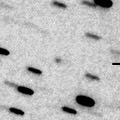
|
It is observable at 18 mag in good condition from January to March.
Date(TT) R.A. (2000) Decl. Delta r Elong. m1 Best Time(A, h)
Dec. 31 10 53.18 -4 39.1 2.574 3.089 112 18.0 4:15 ( 0, 50)
Jan. 7 10 53.61 -5 32.6 2.505 3.105 119 17.9 3:48 ( 0, 49)
|
|
![]()
 C/2014 OE4 ( PanSTARRS )
C/2014 OE4 ( PanSTARRS ) C/2016 A1 ( PanSTARRS )
C/2016 A1 ( PanSTARRS ) C/2013 V4 ( Catalina )
C/2013 V4 ( Catalina ) D/1978 R1 ( Haneda-Campos )
D/1978 R1 ( Haneda-Campos ) C/2014 R3 ( PanSTARRS )
C/2014 R3 ( PanSTARRS ) 188P/LINEAR-Mueller
188P/LINEAR-Mueller C/2014 S2 ( PanSTARRS )
C/2014 S2 ( PanSTARRS ) 118P/Shoemaker-Levy 4
118P/Shoemaker-Levy 4 C/2015 X7 ( ATLAS )
C/2015 X7 ( ATLAS ) P/2015 TP200 ( LINEAR )
P/2015 TP200 ( LINEAR ) C/2013 X1 ( PanSTARRS )
C/2013 X1 ( PanSTARRS ) C/2010 U3 ( Boattini )
C/2010 U3 ( Boattini ) 94P/Russell 4
94P/Russell 4 P/2016 S1 ( PanSTARRS )
P/2016 S1 ( PanSTARRS ) 30P/Reinmuth 1
30P/Reinmuth 1 128P/Shoemaker-Holt 1
128P/Shoemaker-Holt 1 330P/2015 U1 ( Catalina )
330P/2015 U1 ( Catalina )![]()









































